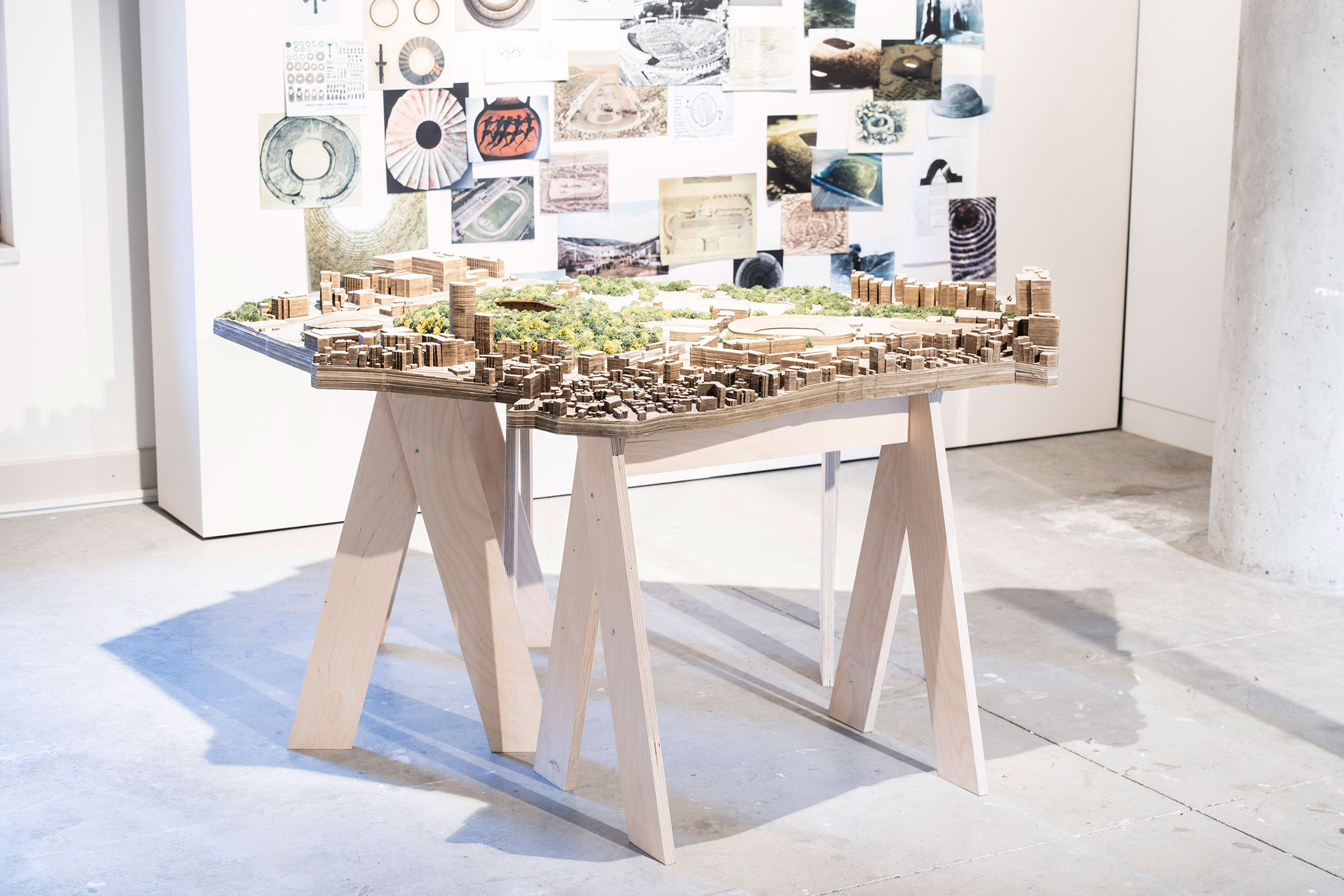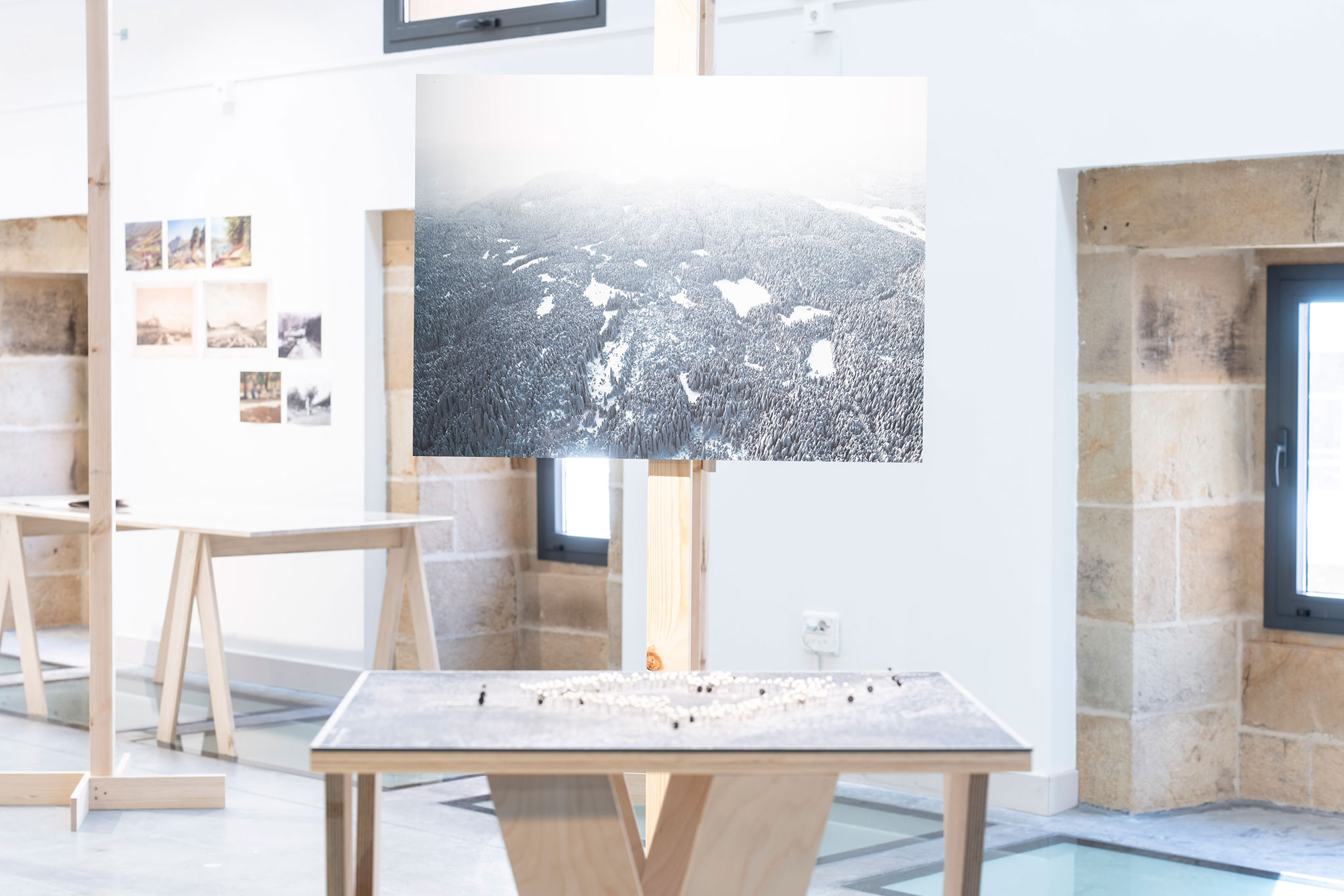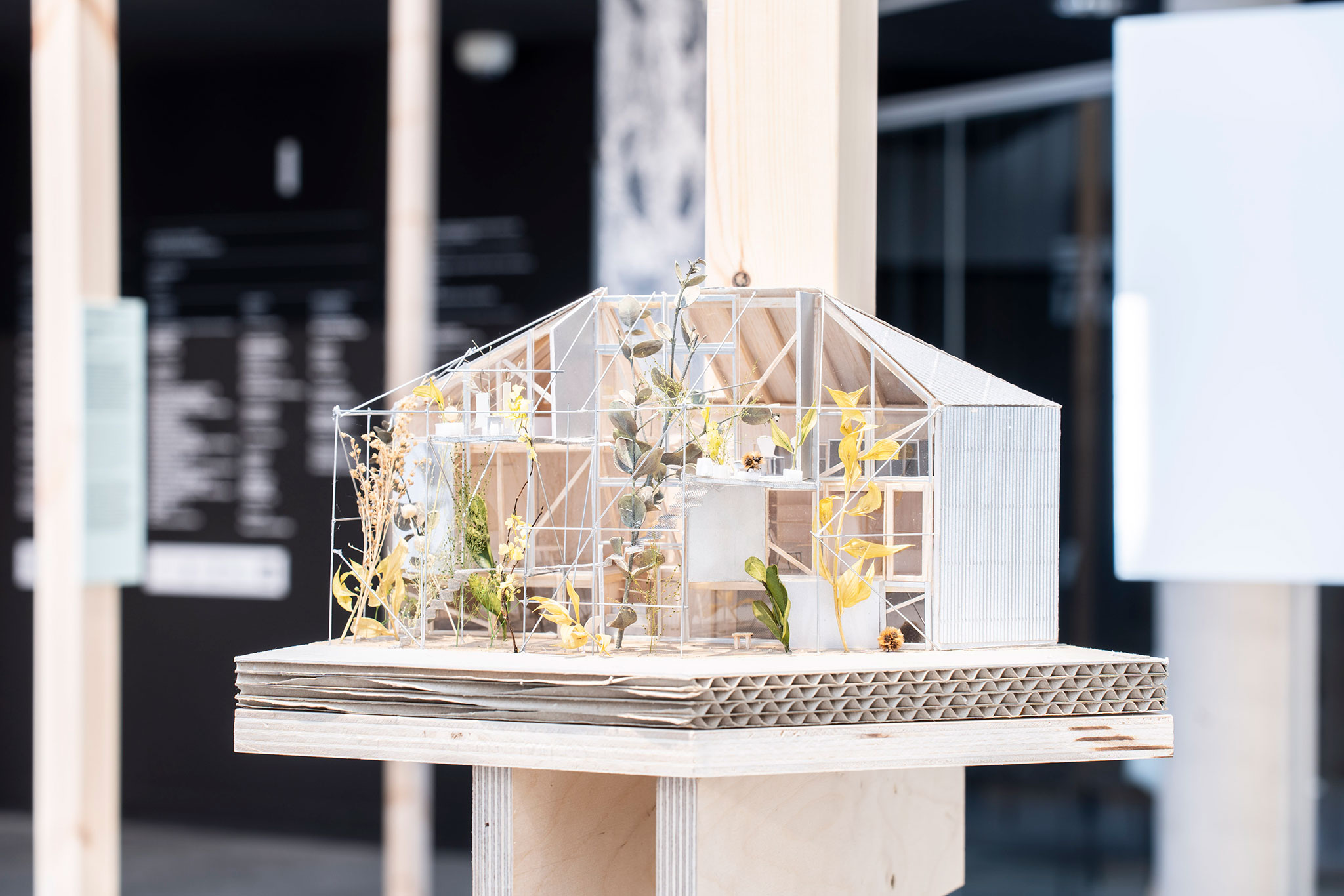Euskadi Institute of Architecture today inaugurated the first exhibition of 2024: «Arboretum. "Trees as architecture." The exhibition was presented for the first time in 2021 at the Arc en Rêve Architecture Centre in Bordeaux to reaffirm the architectural character of trees and highlight how they have been the object of architectural reflection.
Although the precision of materials such as bricks contrasts with the unpredictability of elements such as branches or roots, the truth is that trees occupy an important place in the history of architecture. On the one hand, they have been the source of one of the main construction materials for centuries. On the other hand, they are one of the fundamental elements of architectural design and urban development projects. Sometimes preserved, sometimes integrated into different interventions, trees often coincide with the intentions of architecture, urban planning and landscaping professionals.

Arboretum, Trees as architecture. Photograph by Mikel Blasco.
«Arboretum. “Trees as Architecture” aims to reflect how architecture and trees have always been closely linked. To do this, it brings together a multitude of examples selected from all over the world and different periods. Distributed throughout the space of the rooms as if it were a forest, they define a continuous landscape, allowing the public to wander freely, create free associations and build their network of links and interpretations.
The original exhibition has been adapted to the spaces of the Institute of Architecture of Euskadi, as well as expanded with local examples to adapt to the current architectural, urban and landscape of the region. In total, 23 specific examples can be found represented in different formats, such as models, engravings, drawings, photographs, books and audiovisual materials.
A private arboretum
An arboretum is a collection of trees arranged in a garden area, a reference from which the exhibition starts. This one, in particular, brings together examples from all over the world, coming from more than 25 collections.
Among the pieces on display, you can find drawings from the Drawing Matter collection in London (1796-1959), by authors such as Le Corbusier, who explore the role of drawing in architectural thought and practice. Also, sketches were made by the renowned architect Álvaro Siza, who used the same pencil strokes to represent buildings and plants.

Arboretum, Trees as architecture. Photograph by Mikel Blasco.
Plans, images and models reflect many other cases where trees have served as inspiration to design projects around the world. Among them, is an unbuilt stadium for the 2020 Olympic Games in Japan, which was inspired by the idea of how planted soils can counteract the consequences of climate change in urban environments by retaining rainwater. Or the daita2019 House, in Japan, whose design, based on scaffolding and platforms between which trees grow, was inspired by the feeling of spaciousness of a house that, like a tree, is capable of evolving according to the needs of its occupants.
The natural environment that trees build has also been fundamental for architectural professionals. In the exhibition you can see the case of a hotel in Sri Lanka, designed to adapt to the forest where it is located and on whose roof more trees have been planted, making it disappear from view. Or a forest building, built for a supermarket chain in the United States, which instead of cutting down the trees on the plot, split the building in two so that they could remain in place.
In addition to inspiration or scenery, trees have also been used for construction. 'Arboretum' reflects the case of the Sharjah Oasis, in the United Arab Emirates, where the OFFICE studio used palm trees between metal meshes to locate them in the centre of the city and build a space to meet and cool off. Or the malls that emerged in Euskadi after the Enlightenment to provide leisure spaces to the walled cities.
One of the local concepts that has been added to the exhibition on this occasion is that of the tree as a symbolic element, under whose shadow the first political space was established. It was a Basque tradition and that of other cultures in northern Spain to have one in sacred, spiritual places or with an institutional component, and three recognized Basque trees are shown as examples.

Arboretum, Trees as architecture. Photograph by Mikel Blasco.
Complementary program
«Arboretum. "Trees as Architecture" will be open until October 2024, during which time different activities will be organized that will bring the reflections of the exhibition out of its rooms. There will be different conferences and meetings that have been divided into three thematic blocks. The first of them, 'Hezi', will focus on the renaturalization of school spaces, where driving agents of different projects that are already taking place in Euskadi and other places will participate. It will be from April 17 to 19.
Secondly, "Bizi", will address the tree as a human habitat. It will take place in May and will focus on the tree heritage of our territory, where the public will be able to learn more about the species that inhabit our cities, their choice, and their care... Finally, the "Pentsatu" block will bring a series of conferences to reflect on the tree as architecture, in September.

Arboretum, Trees as architecture. Photograph by Mikel Blasco.
As usual, the exhibition is accompanied by family workshops led by Maushaus. The first will take place on April 6, May 18, June 8 and June 22. The traditional summer camp for boys and girls will also be held the week of June 24. Additionally, as a novelty, a series of workshops for adults will be offered in July for the first time.
The Institute of Architecture of Euskadi offers free guided tours for school groups from 5th grade of Primary to High School where, in addition to the exhibition, they will be able to see this unique building, in the heart of the Old Town of Donostia on the slopes of Mount Urgull.
Although the precision of materials such as bricks contrasts with the unpredictability of elements such as branches or roots, the truth is that trees occupy an important place in the history of architecture. On the one hand, they have been the source of one of the main construction materials for centuries. On the other hand, they are one of the fundamental elements of architectural design and urban development projects. Sometimes preserved, sometimes integrated into different interventions, trees often coincide with the intentions of architecture, urban planning and landscaping professionals.

Arboretum, Trees as architecture. Photograph by Mikel Blasco.
«Arboretum. “Trees as Architecture” aims to reflect how architecture and trees have always been closely linked. To do this, it brings together a multitude of examples selected from all over the world and different periods. Distributed throughout the space of the rooms as if it were a forest, they define a continuous landscape, allowing the public to wander freely, create free associations and build their network of links and interpretations.
The original exhibition has been adapted to the spaces of the Institute of Architecture of Euskadi, as well as expanded with local examples to adapt to the current architectural, urban and landscape of the region. In total, 23 specific examples can be found represented in different formats, such as models, engravings, drawings, photographs, books and audiovisual materials.
A private arboretum
An arboretum is a collection of trees arranged in a garden area, a reference from which the exhibition starts. This one, in particular, brings together examples from all over the world, coming from more than 25 collections.
Among the pieces on display, you can find drawings from the Drawing Matter collection in London (1796-1959), by authors such as Le Corbusier, who explore the role of drawing in architectural thought and practice. Also, sketches were made by the renowned architect Álvaro Siza, who used the same pencil strokes to represent buildings and plants.

Arboretum, Trees as architecture. Photograph by Mikel Blasco.
Plans, images and models reflect many other cases where trees have served as inspiration to design projects around the world. Among them, is an unbuilt stadium for the 2020 Olympic Games in Japan, which was inspired by the idea of how planted soils can counteract the consequences of climate change in urban environments by retaining rainwater. Or the daita2019 House, in Japan, whose design, based on scaffolding and platforms between which trees grow, was inspired by the feeling of spaciousness of a house that, like a tree, is capable of evolving according to the needs of its occupants.
The natural environment that trees build has also been fundamental for architectural professionals. In the exhibition you can see the case of a hotel in Sri Lanka, designed to adapt to the forest where it is located and on whose roof more trees have been planted, making it disappear from view. Or a forest building, built for a supermarket chain in the United States, which instead of cutting down the trees on the plot, split the building in two so that they could remain in place.
In addition to inspiration or scenery, trees have also been used for construction. 'Arboretum' reflects the case of the Sharjah Oasis, in the United Arab Emirates, where the OFFICE studio used palm trees between metal meshes to locate them in the centre of the city and build a space to meet and cool off. Or the malls that emerged in Euskadi after the Enlightenment to provide leisure spaces to the walled cities.
One of the local concepts that has been added to the exhibition on this occasion is that of the tree as a symbolic element, under whose shadow the first political space was established. It was a Basque tradition and that of other cultures in northern Spain to have one in sacred, spiritual places or with an institutional component, and three recognized Basque trees are shown as examples.

Arboretum, Trees as architecture. Photograph by Mikel Blasco.
Complementary program
«Arboretum. "Trees as Architecture" will be open until October 2024, during which time different activities will be organized that will bring the reflections of the exhibition out of its rooms. There will be different conferences and meetings that have been divided into three thematic blocks. The first of them, 'Hezi', will focus on the renaturalization of school spaces, where driving agents of different projects that are already taking place in Euskadi and other places will participate. It will be from April 17 to 19.
Secondly, "Bizi", will address the tree as a human habitat. It will take place in May and will focus on the tree heritage of our territory, where the public will be able to learn more about the species that inhabit our cities, their choice, and their care... Finally, the "Pentsatu" block will bring a series of conferences to reflect on the tree as architecture, in September.

Arboretum, Trees as architecture. Photograph by Mikel Blasco.
As usual, the exhibition is accompanied by family workshops led by Maushaus. The first will take place on April 6, May 18, June 8 and June 22. The traditional summer camp for boys and girls will also be held the week of June 24. Additionally, as a novelty, a series of workshops for adults will be offered in July for the first time.
The Institute of Architecture of Euskadi offers free guided tours for school groups from 5th grade of Primary to High School where, in addition to the exhibition, they will be able to see this unique building, in the heart of the Old Town of Donostia on the slopes of Mount Urgull.































































